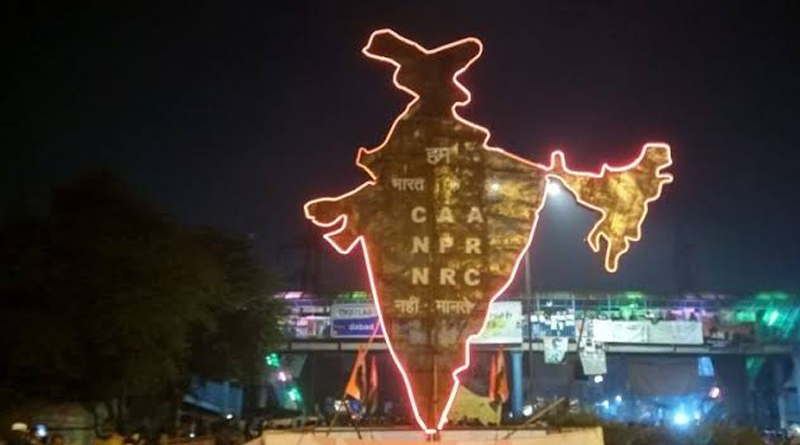There are implications from Shaheen Bagh beyond critiquing CAA
Swaminathan S Anklesaria Aiyar
The Constitution is celebrated on Republic Day, January 26. But its celebration began in Shaheen Bagh, New Delhi, on December 15 in protest against police brutality in quelling student demonstration at Jamia Millia Islamia against the Citizenship (Amendment) Act (CAA). It started as a sitin protest by Muslim women blocking a major road. But it quickly blossomed into a passionate agitation by Muslims across India to proclaim themselves as patriotic Indians swearing by the Constitution, vowing to protect it against those in power breaching it.
Visitors to Shaheen Bagh may think a small group of 500 women cannot hold out for long or have much impact. In fact, Shaheen Bagh has changed India, threatening to halt Narendra Modi’s once-unstoppable juggernaut.
Anti-Climax for Opposition
When the CAA was debated in Parliament, opposition parties looked cowed and unwilling to object loudly for fear of being called anti-national. But then students’ protests exploded in several cities, followed by Muslim women’s demonstration first at Shaheen Bagh and then in dozens of cities across BJP-ruled states. This galvanised opposition parties to refuse to cry ‘unconstitutional’ and refuse to implement the CAA and proposed all-India National Register of Citizens (NRC) in non-BJP states. This non-implementation means the CAA has become unimplementable, a stunning victory for the women of Shaheen Bagh.
On Republic Day, millions of protesters in Kerala formed a 620-km human chain, and others in Kolkata formed another 11-km chain. Never before has the government faced such wide, passionate resistance. The claim that the CAA is a harmless way of helping persecuted Hindus has been dismissed with jeers across the world. India has been castigated for human rights violations by the media and top politicians in the US, EU and Asia.
The BJP has fought back by stopping refined palm oil imports from Malaysia after its prime minister criticised India for human rights violations. This is no way to convince critics, who can see that the NRC and CAA are two pincers that can grip and strip citizenship from millions of Indian Muslims lacking documents.
In Assam, the NRC exercise revealed 1.9 million people without documents, including 1.2 million Hindus and 0.7 million Muslims. Clearly, an exercise to weed out ‘termites’ and ‘ghuspaithiyas’ from Bangladesh simply caught poor people lacking documents, which is common in a low-documentation country. Projecting the Assam experience, a national NRC could cost ₹50,000 crore and trap 80 million undocumented people. Some Rashtriya Swayamsevak Sangh members will rejoice at the thought of incarcerating millions of Muslims. But India’s global reputation will be mud, and rightly so.
The BJP portrays the agitation as anti-national sabotage. A visit to the place shows the profusion of banners, billboards and paintings highlighting the Constitution’s preamble. Muslims are chanting the preamble and Constitution, swearing to uphold it as patriotic Indians.
“We, the people of India, having solemnly resolved to constitute India into a sovereign socialist secular democratic republic and to secure to all its citizens JUSTICE, social, economic and political; LIBERTY of thought, expression, belief, faith and worship; EQUALITY of status and of opportunity; and to promote among them all FRATERNITY assuring the dignity of the individual and the unity and integrity of the Nation; In our Constituent Assembly this 26th day of November 1949 do hereby adopt, enact and give to ourselves this Constitution.”
Getting Patriotism Right
These 85 words are emblazoned not only on banners at protest sites but on a million T-shirts selling like hot cakes.
BJP spokesmen paint Shaheen Bagh as a mini-Pakistan funded by Islamic radicals. Does the BJP really think Pakistan is financing a movement that swears by the Constitution? That swears that Muslims are loyal patriotic Indians? That swears by the teachings of Mahatma Gandhi, Bhimrao Ambedkar, Subhas Chandra Bose, Bhagat Singh and Sarojini Naidu?
Giant photos of these luminaries festoon the speaking dais at Shaheen Bagh. The women come and go in relays every two or three hours, so the tent remains full and the agitation seems sustainable indefinitely. Women wear headbands saying ‘I love India’, wave the national flag and sing the national anthem. They have stolen Indian patriotism from under the BJP’s nose.
The banner I liked best at Shaheen Bagh was a clever twist on Guru Dutt’s song from the film Pyaasa, “Jinhe naaz hai Hind par, woh kahan hain? Kahan hain… kahan hain… kahan hain?” (Those proud of India, where are they? Where are they? Where are they? Where are they?) The Shaheen Bagh version says, “Jinhe naaz hain Hind par, woh kahan hain? Yahan hain… yahan hain… yahan hain!” (Those proud of India, where are they? They are here, they are here, they are here!) Recently, the Supreme Court has seemed to bend towards the BJP in many verdicts. Global experience shows courts are influenced by the political climate.
The BJP rode a great wave to win hands down in the 2019 general election. Opposition parties licked their wounds and hardly resisted the CAA in Parliament. But India’s students and the Shaheen Bagh women have helped the Opposition find its voice again. Hopefully, the Supreme Court too will raise its voice as the unbending protector of constitutional rights.


